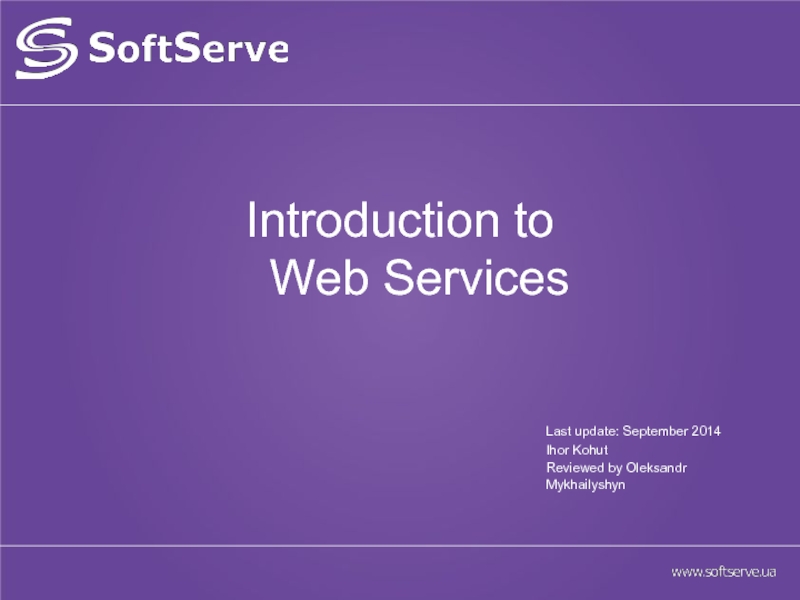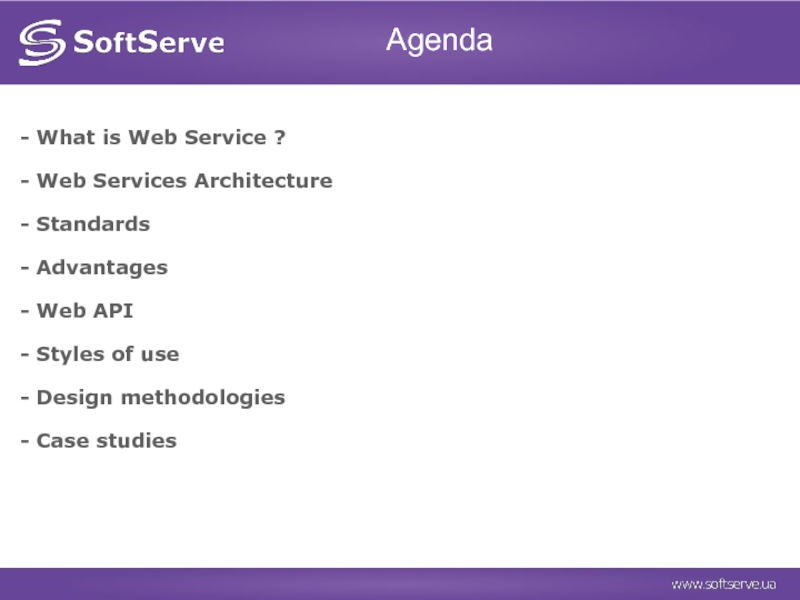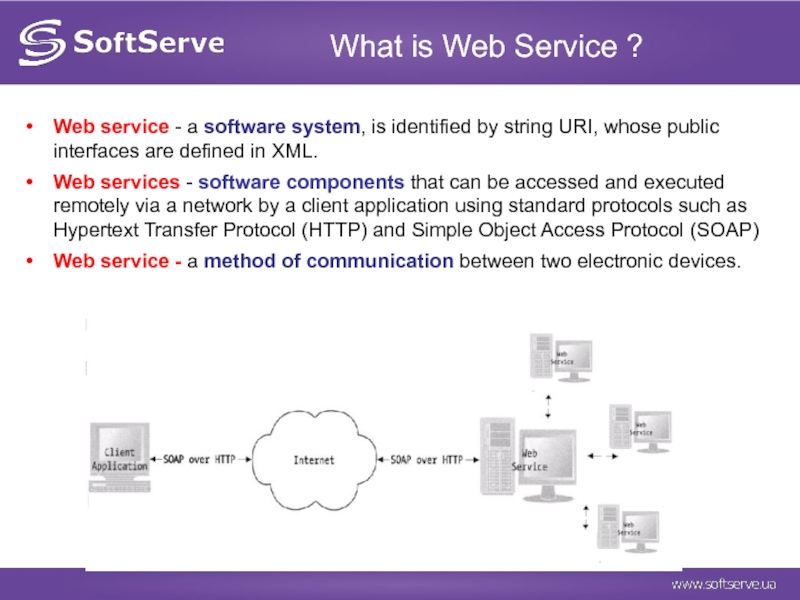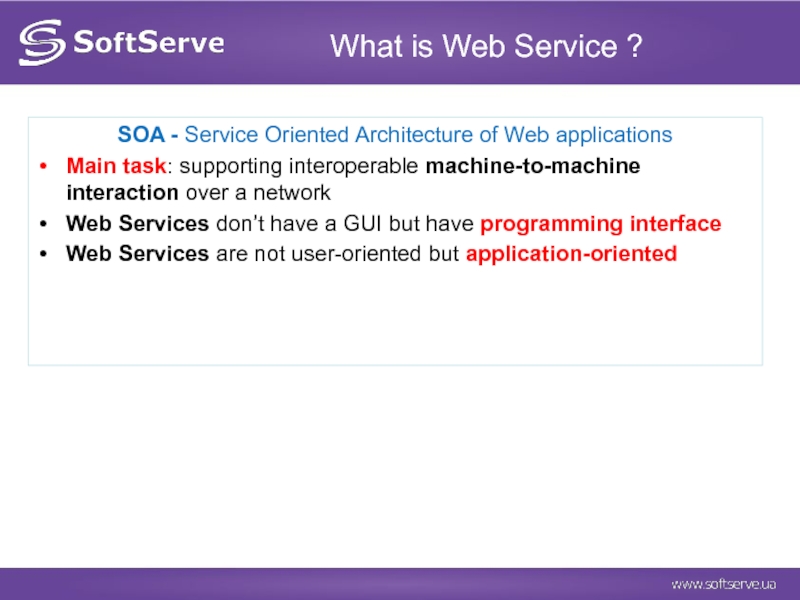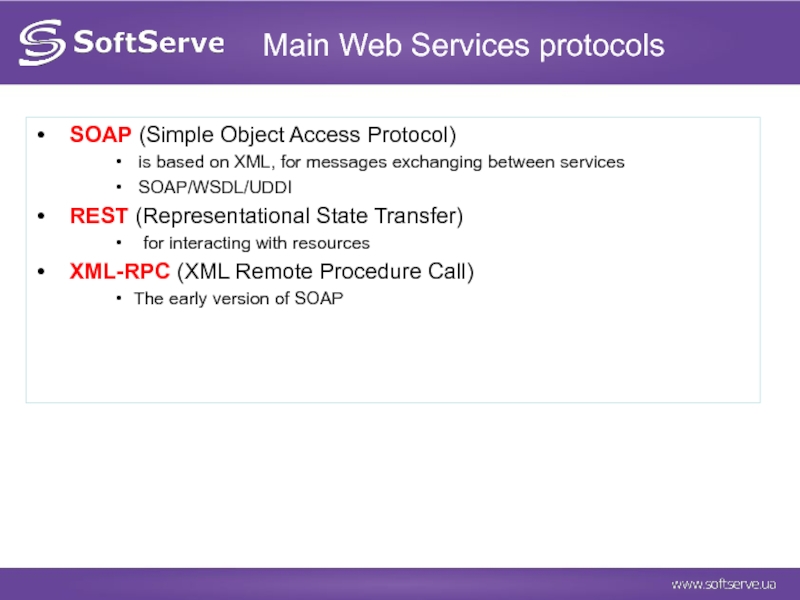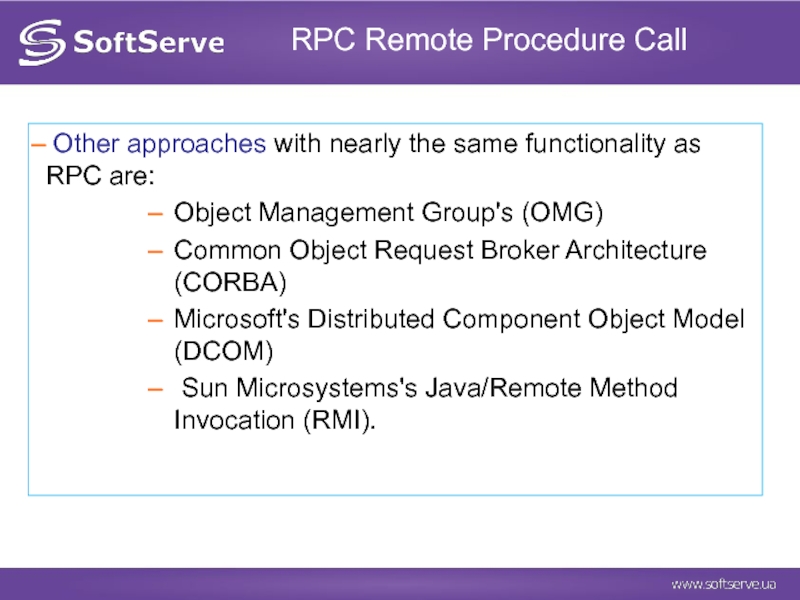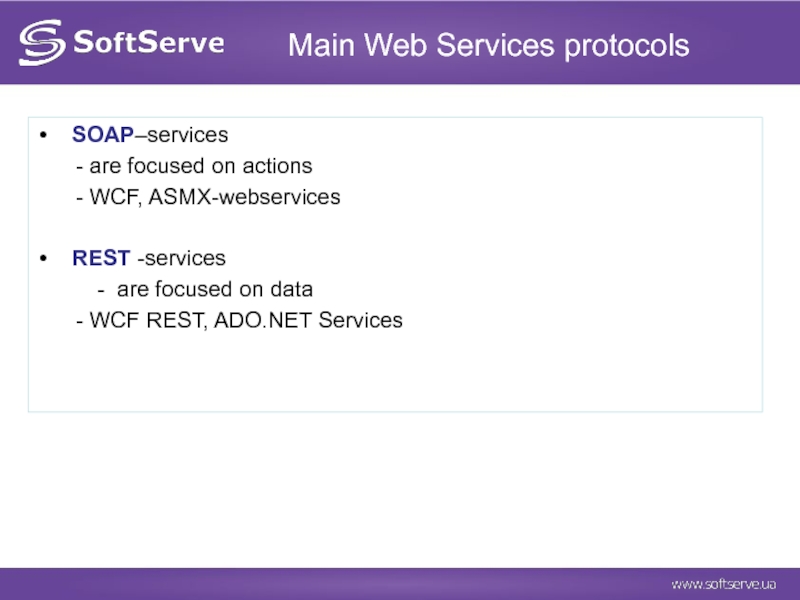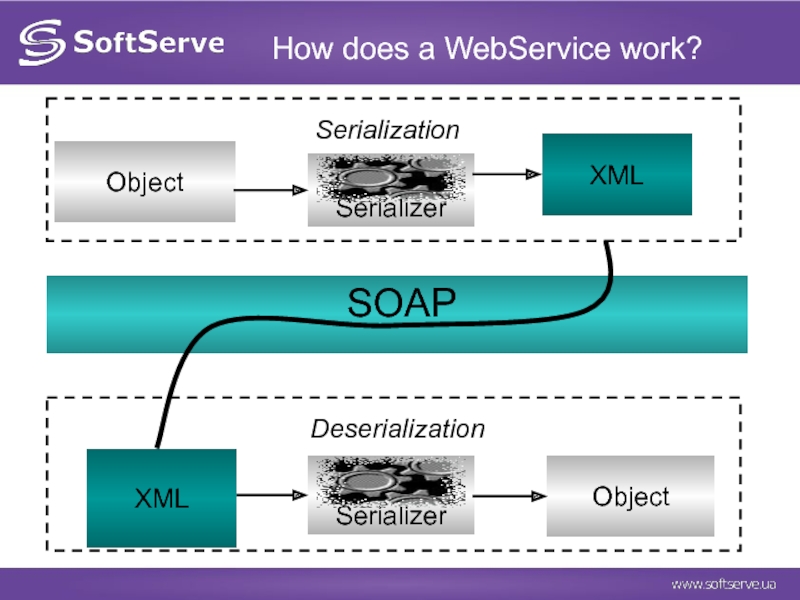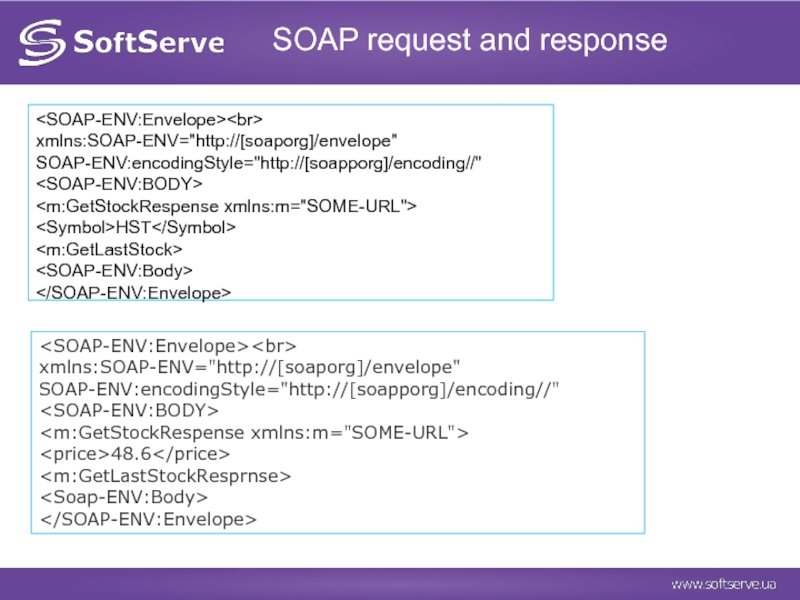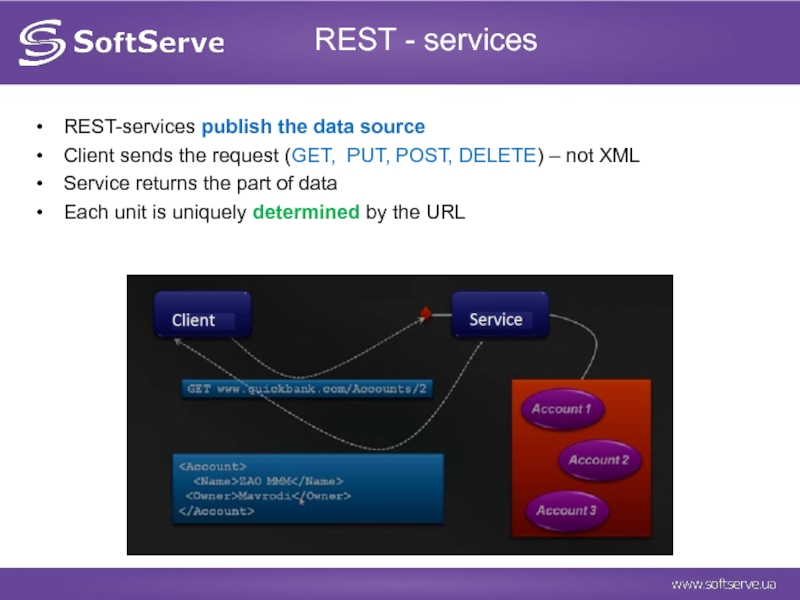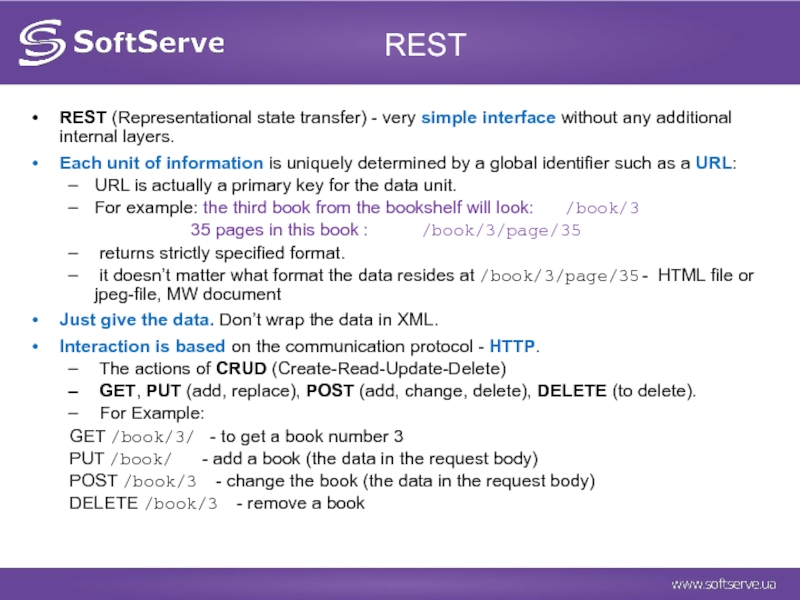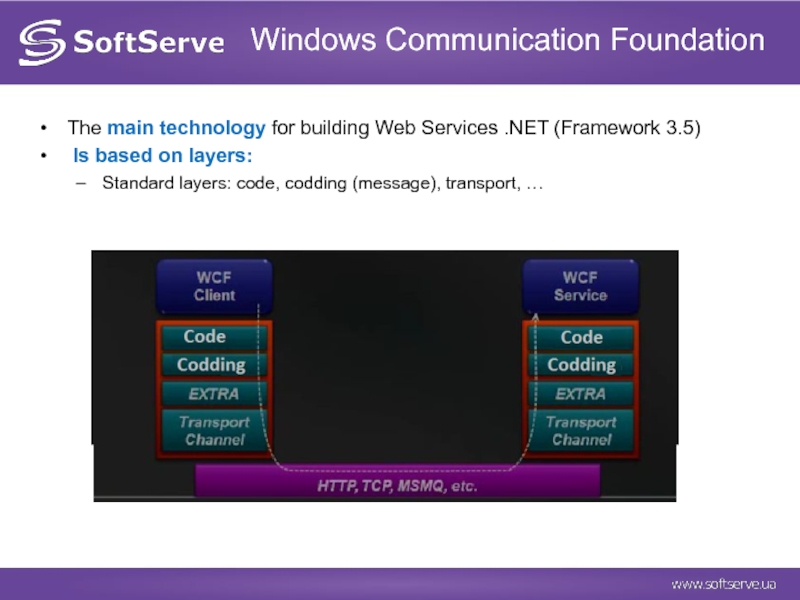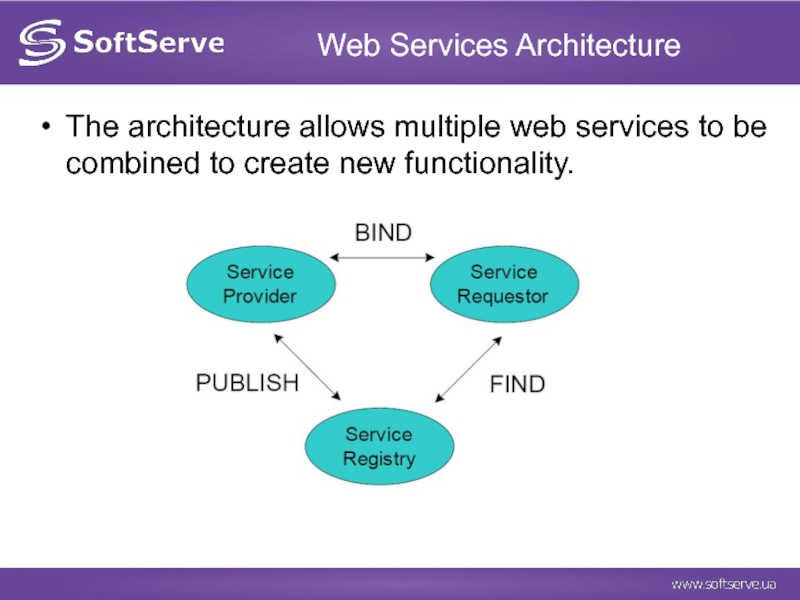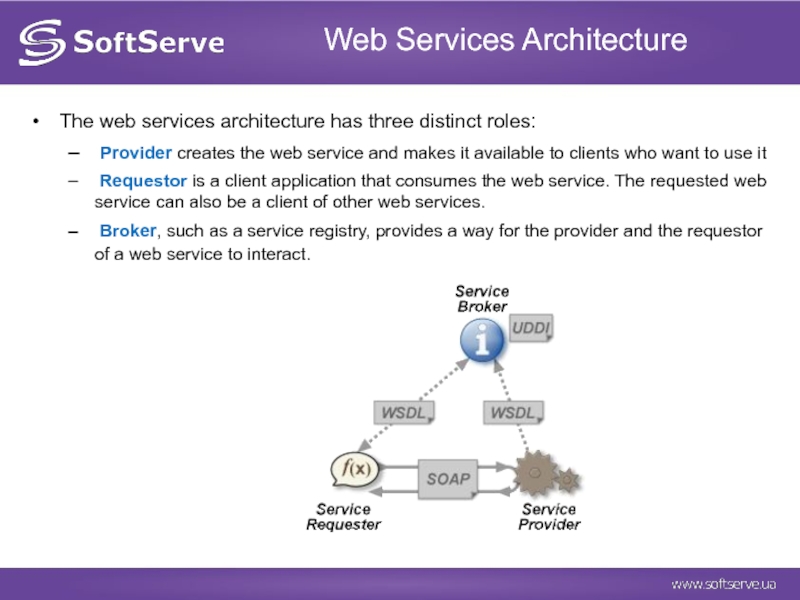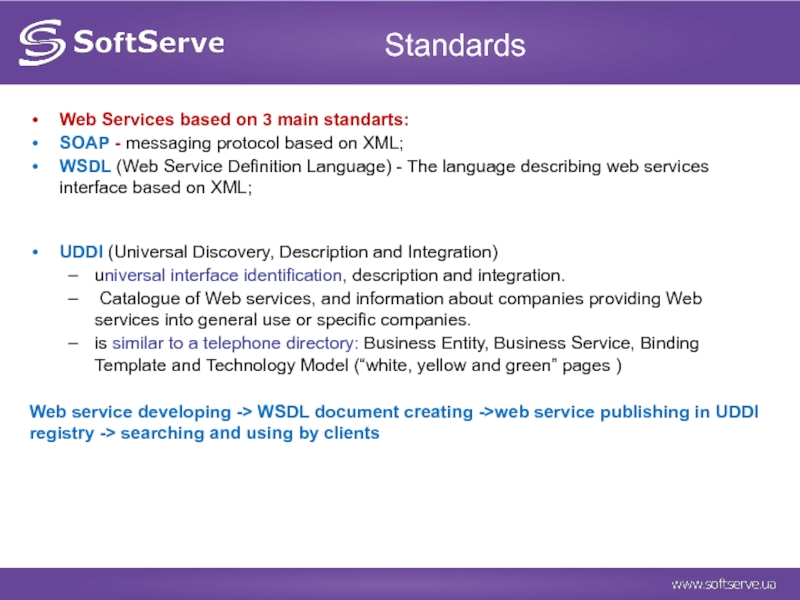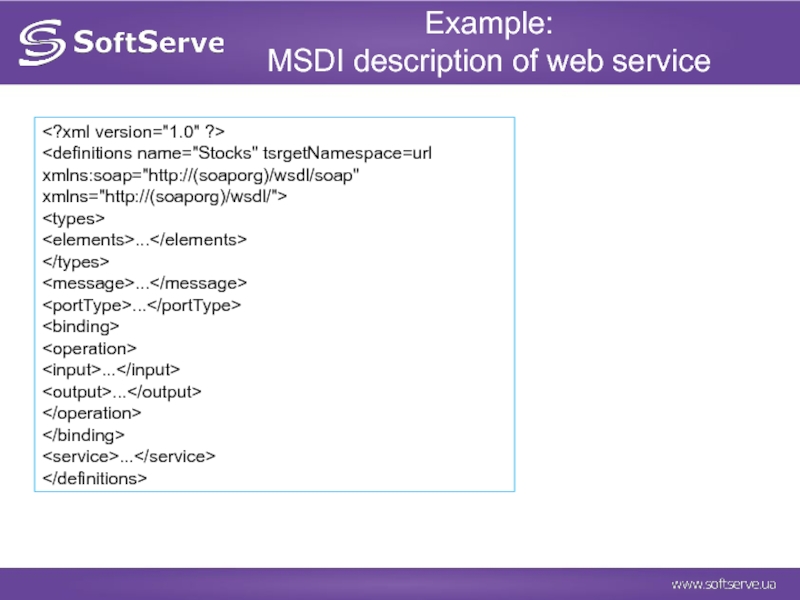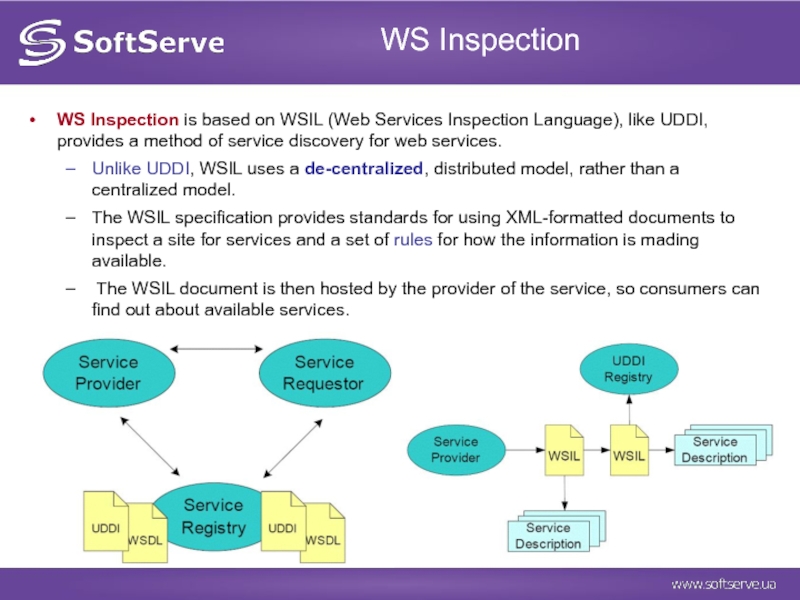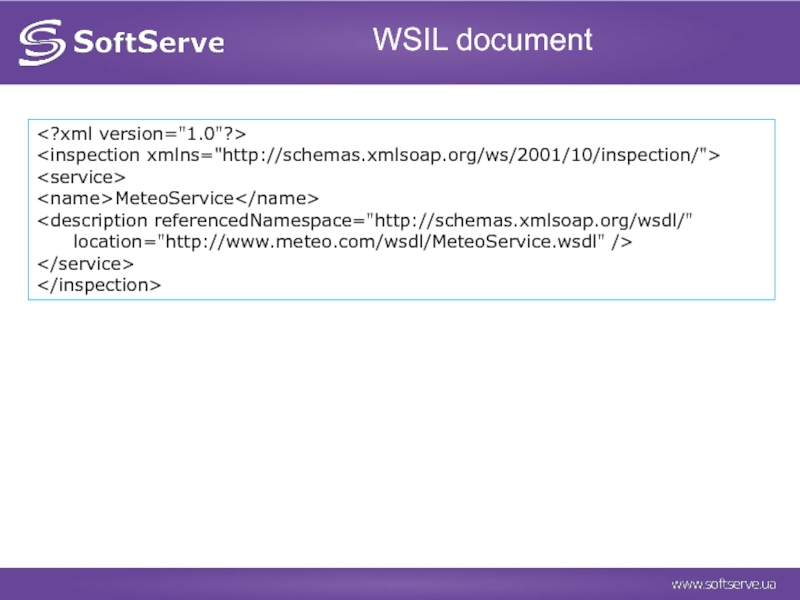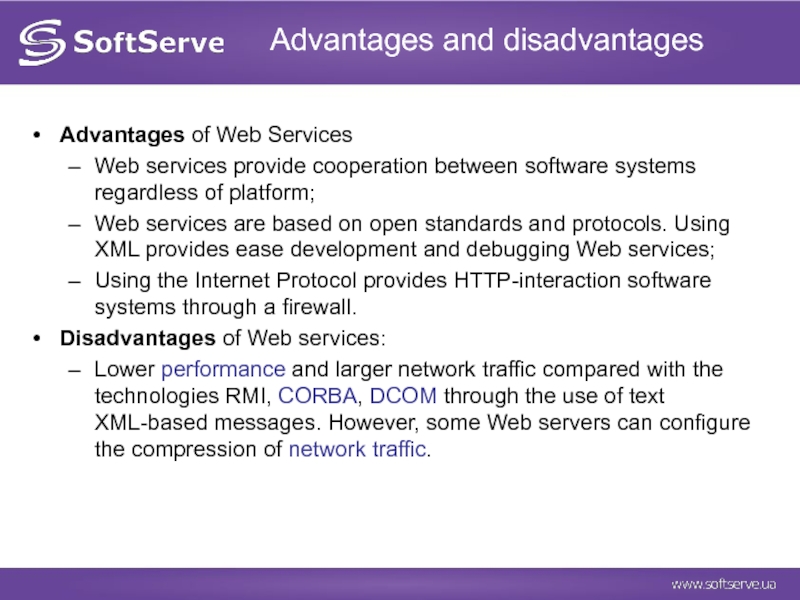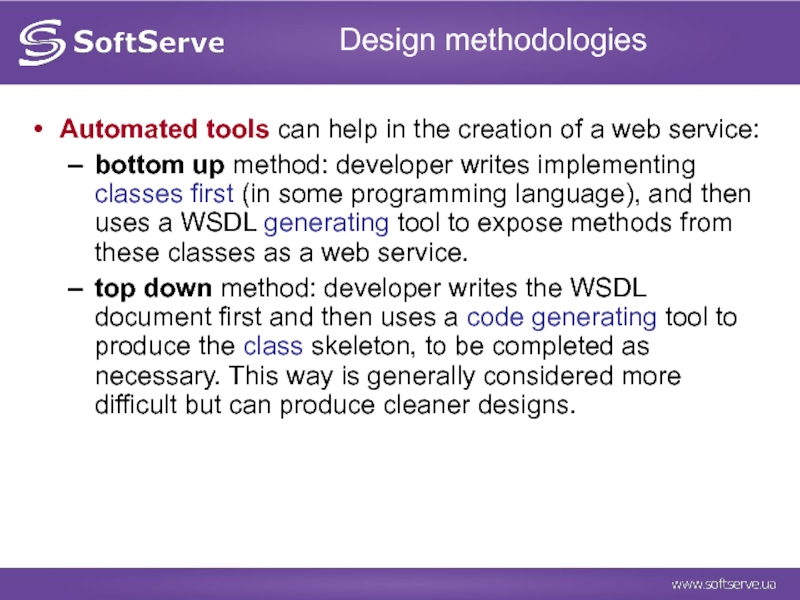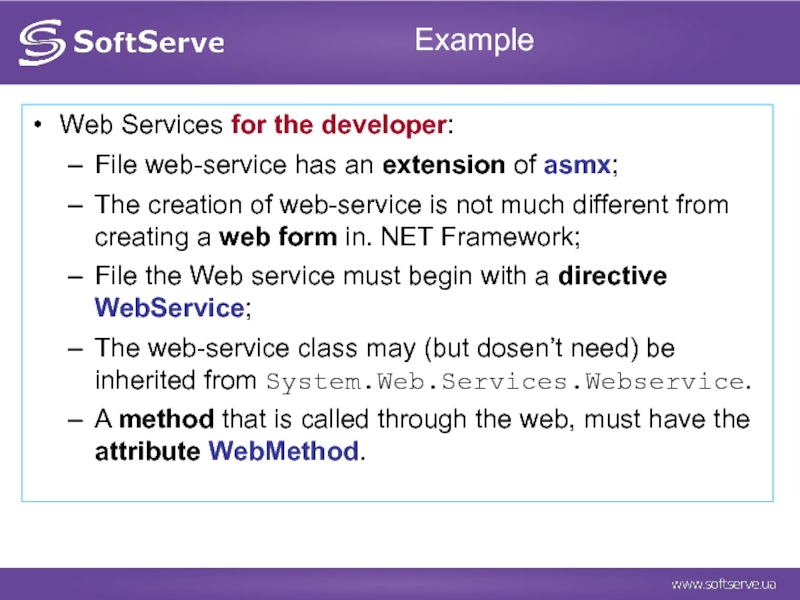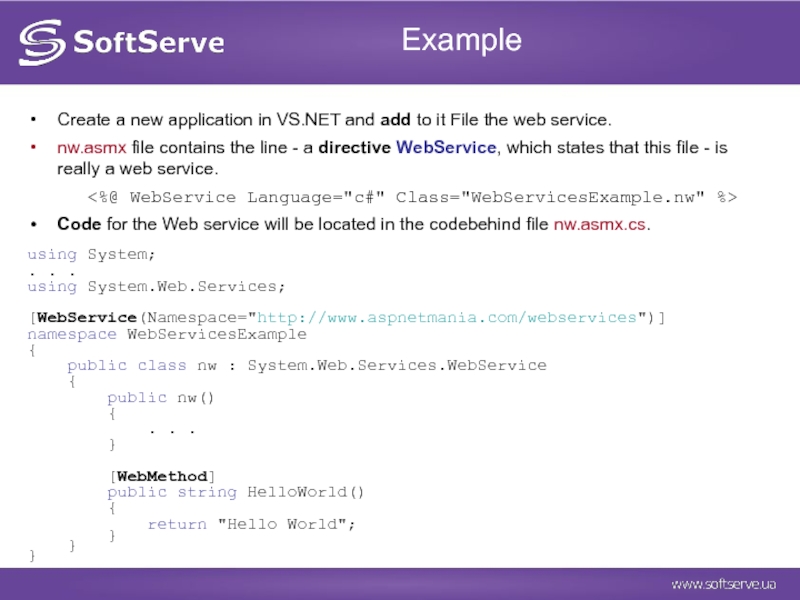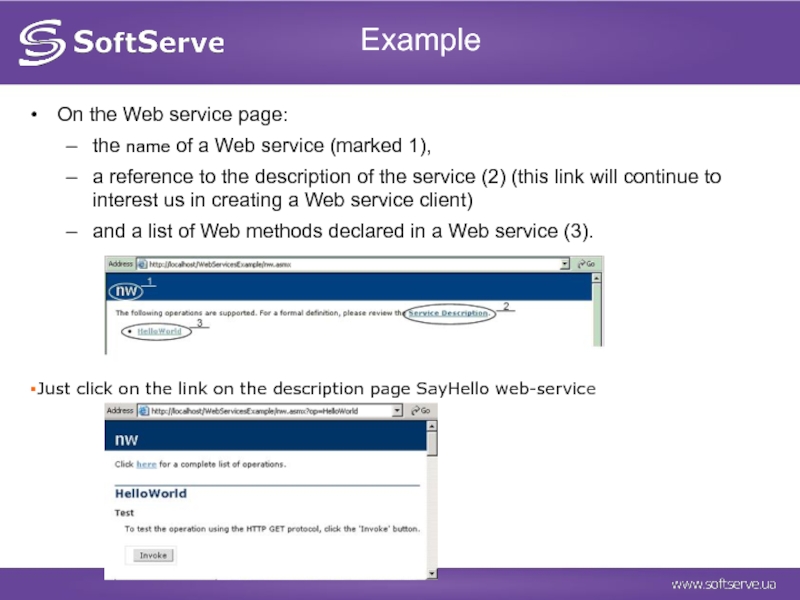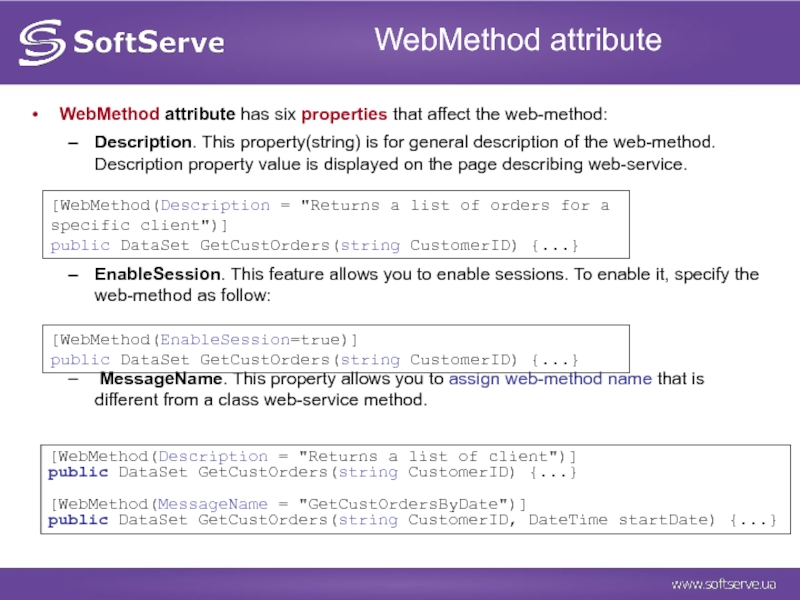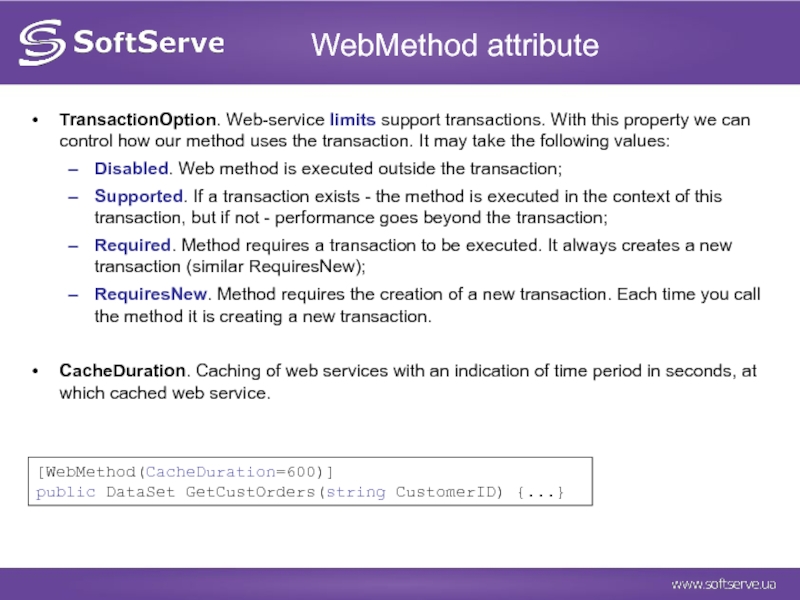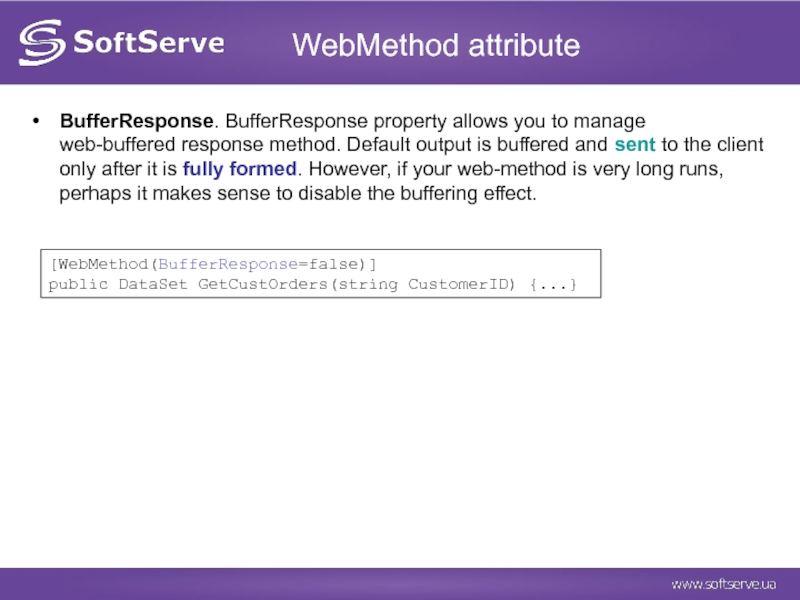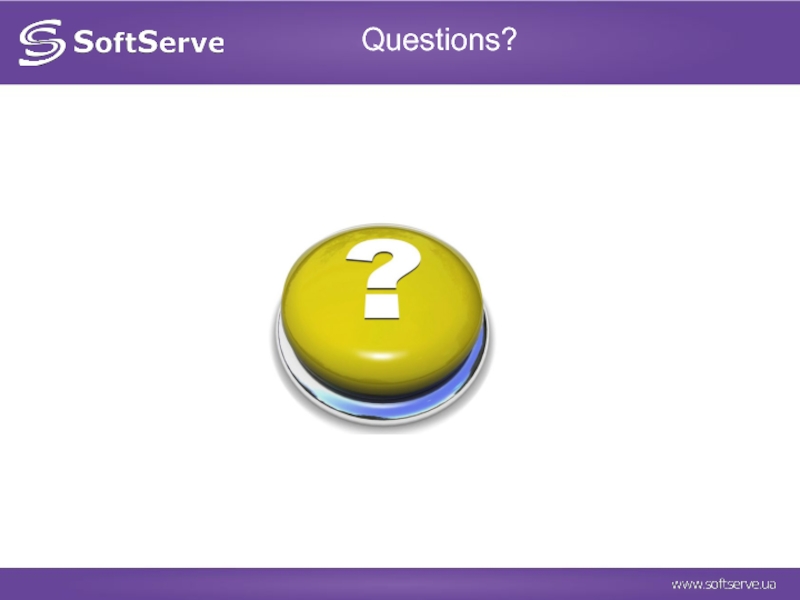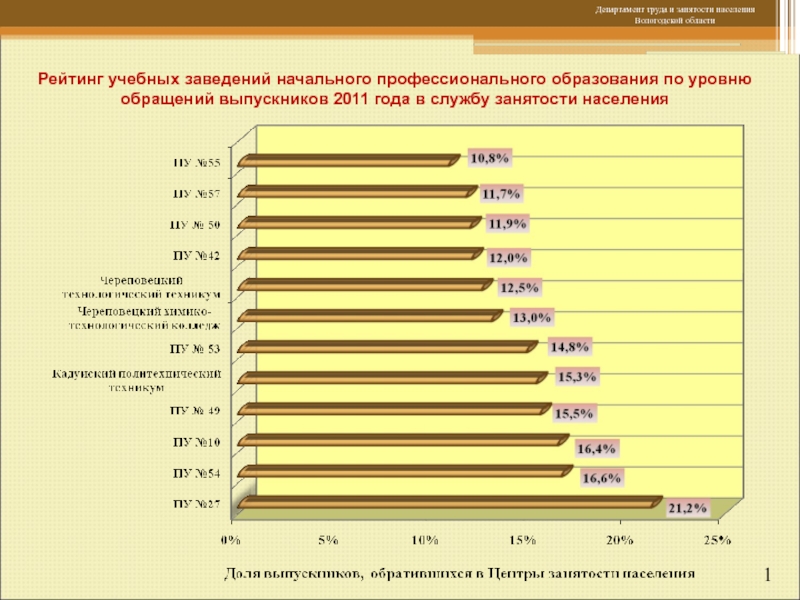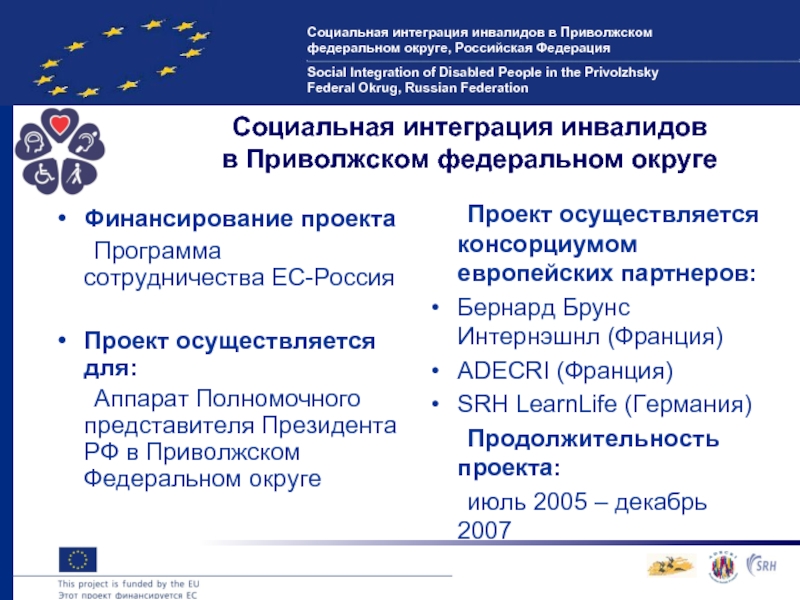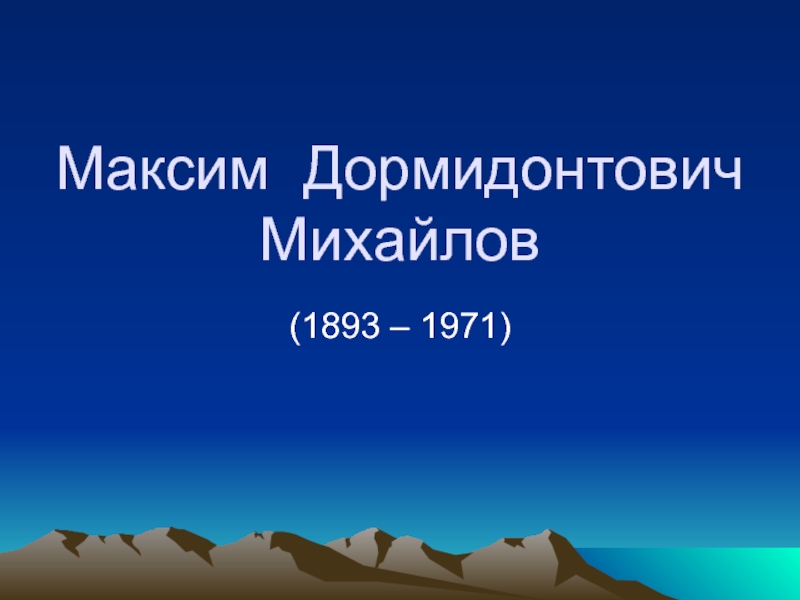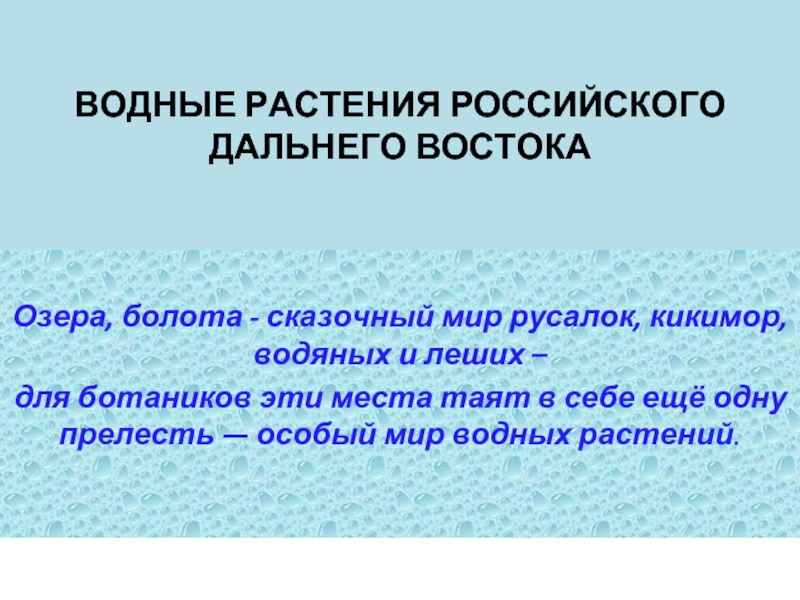- Главная
- Разное
- Дизайн
- Бизнес и предпринимательство
- Аналитика
- Образование
- Развлечения
- Красота и здоровье
- Финансы
- Государство
- Путешествия
- Спорт
- Недвижимость
- Армия
- Графика
- Культурология
- Еда и кулинария
- Лингвистика
- Английский язык
- Астрономия
- Алгебра
- Биология
- География
- Детские презентации
- Информатика
- История
- Литература
- Маркетинг
- Математика
- Медицина
- Менеджмент
- Музыка
- МХК
- Немецкий язык
- ОБЖ
- Обществознание
- Окружающий мир
- Педагогика
- Русский язык
- Технология
- Физика
- Философия
- Химия
- Шаблоны, картинки для презентаций
- Экология
- Экономика
- Юриспруденция
Introduction to Web Services презентация
Содержание
- 1. Introduction to Web Services
- 2. Agenda What is Web Service ?
- 3. What is Web Service ? Web service
- 4. SOA - Service Oriented Architecture of Web
- 5. Main Web Services protocols SOAP (Simple
- 6. RPC Remote Procedure Call Other
- 7. Main Web Services protocols SOAP–services -
- 8. SOAP - services SOAP-services publish the “contract”
- 9. How does a WebService work?
- 10. SOAP request and response
- 11. REST - services REST-services publish the data
- 12. REST REST (Representational state transfer) - very
- 13. Windows Communication Foundation The main technology for
- 14. Web Services Architecture The architecture allows multiple
- 15. Web Services Architecture The web services architecture
- 16. Standards Web Services based on 3 main
- 17. Example: MSDI description of web service
- 18. WS Inspection WS Inspection is based on
- 19. WSIL document MeteoService
- 20. Advantages and disadvantages Advantages of Web Services
- 21. Design methodologies Automated tools can help in
- 22. Example Web Services for the developer: File
- 23. Example Create a new application in VS.NET
- 24. Example On the Web service page: the
- 25. WebMethod attribute WebMethod attribute has six properties
- 26. WebMethod attribute TransactionOption. Web-service limits support transactions.
- 27. WebMethod attribute BufferResponse. BufferResponse property allows you
- 28. Questions?
Слайд 1Introduction to
Web Services
Last update: September 2014
Ihor Kohut
Reviewed by Oleksandr Mykhailyshyn
Слайд 2Agenda
What is Web Service ?
Web Services Architecture
Standards
Web API
Styles of use
Design methodologies
Case studies
Слайд 3What is Web Service ?
Web service - a software system, is
Web services - software components that can be accessed and executed remotely via a network by a client application using standard protocols such as Hypertext Transfer Protocol (HTTP) and Simple Object Access Protocol (SOAP)
Web service - a method of communication between two electronic devices.
Слайд 4SOA - Service Oriented Architecture of Web applications
Main task: supporting interoperable
Web Services don’t have a GUI but have programming interface
Web Services are not user-oriented but application-oriented
What is Web Service ?
Слайд 5Main Web Services protocols
SOAP (Simple Object Access Protocol)
is based
SOAP/WSDL/UDDI
REST (Representational State Transfer)
for interacting with resources
XML-RPC (XML Remote Procedure Call)
The early version of SOAP
Слайд 6RPC Remote Procedure Call
Other approaches with nearly the same
Object Management Group's (OMG)
Common Object Request Broker Architecture (CORBA)
Microsoft's Distributed Component Object Model (DCOM)
Sun Microsystems's Java/Remote Method Invocation (RMI).
Слайд 7Main Web Services protocols
SOAP–services
- are focused on actions
- WCF, ASMX-webservices
REST -services
- are focused on data
- WCF REST, ADO.NET Services
Слайд 8SOAP - services
SOAP-services publish the “contract” (set of methods, parameters and
Clients know about contract – call methods (using XML), which are executed on service
Interaction with service - throw endpoints:
URL-address of web service
binding – interaction protocol, security parameters
Слайд 10SOAP request and response
xmlns:SOAP-ENV="http://[soaporg]/envelope"
SOAP-ENV:encodingStyle="http://[soapporg]/encoding//"
HST
xmlns:SOAP-ENV="http://[soaporg]/envelope"
SOAP-ENV:encodingStyle="http://[soapporg]/encoding//"
48.6
Слайд 11REST - services
REST-services publish the data source
Client sends the request
Service returns the part of data
Each unit is uniquely determined by the URL
Слайд 12REST
REST (Representational state transfer) - very simple interface without any additional
Each unit of information is uniquely determined by a global identifier such as a URL:
URL is actually a primary key for the data unit.
For example: the third book from the bookshelf will look: /book/3
35 pages in this book : /book/3/page/35
returns strictly specified format.
it doesn’t matter what format the data resides at /book/3/page/35 - HTML file or jpeg-file, MW document
Just give the data. Don’t wrap the data in XML.
Interaction is based on the communication protocol - HTTP.
The actions of CRUD (Create-Read-Update-Delete)
GET, PUT (add, replace), POST (add, change, delete), DELETE (to delete).
For Example:
GET /book/3/ - to get a book number 3
PUT /book/ - add a book (the data in the request body)
POST /book/3 - change the book (the data in the request body)
DELETE /book/3 - remove a book
Слайд 13Windows Communication Foundation
The main technology for building Web Services .NET (Framework
Is based on layers:
Standard layers: code, codding (message), transport, …
Слайд 14Web Services Architecture
The architecture allows multiple web services to be combined
Слайд 15Web Services Architecture
The web services architecture has three distinct roles:
Requestor is a client application that consumes the web service. The requested web service can also be a client of other web services.
Broker, such as a service registry, provides a way for the provider and the requestor of a web service to interact.
Слайд 16Standards
Web Services based on 3 main standarts:
SOAP - messaging protocol based
WSDL (Web Service Definition Language) - The language describing web services interface based on XML;
UDDI (Universal Discovery, Description and Integration)
universal interface identification, description and integration.
Catalogue of Web services, and information about companies providing Web services into general use or specific companies.
is similar to a telephone directory: Business Entity, Business Service, Binding Template and Technology Model (“white, yellow and green” pages )
Web service developing -> WSDL document creating ->web service publishing in UDDI registry -> searching and using by clients
Слайд 18WS Inspection
WS Inspection is based on WSIL (Web Services Inspection Language),
Unlike UDDI, WSIL uses a de-centralized, distributed model, rather than a centralized model.
The WSIL specification provides standards for using XML-formatted documents to inspect a site for services and a set of rules for how the information is mading available.
The WSIL document is then hosted by the provider of the service, so consumers can find out about available services.
Слайд 20Advantages and disadvantages
Advantages of Web Services
Web services provide cooperation between software
Web services are based on open standards and protocols. Using XML provides ease development and debugging Web services;
Using the Internet Protocol provides HTTP-interaction software systems through a firewall.
Disadvantages of Web services:
Lower performance and larger network traffic compared with the technologies RMI, CORBA, DCOM through the use of text XML-based messages. However, some Web servers can configure the compression of network traffic.
Слайд 21Design methodologies
Automated tools can help in the creation of a web
bottom up method: developer writes implementing classes first (in some programming language), and then uses a WSDL generating tool to expose methods from these classes as a web service.
top down method: developer writes the WSDL document first and then uses a code generating tool to produce the class skeleton, to be completed as necessary. This way is generally considered more difficult but can produce cleaner designs.
Слайд 22Example
Web Services for the developer:
File web-service has an extension of asmx;
The
File the Web service must begin with a directive WebService;
The web-service class may (but dosen’t need) be inherited from System.Web.Services.Webservice.
A method that is called through the web, must have the attribute WebMethod.
Слайд 23Example
Create a new application in VS.NET and add to it File
nw.asmx file contains the line - a directive WebService, which states that this file - is really a web service.
<%@ WebService Language="c#" Class="WebServicesExample.nw" %>
Code for the Web service will be located in the codebehind file nw.asmx.cs.
using System;
. . .
using System.Web.Services;
[WebService(Namespace="http://www.aspnetmania.com/webservices")]
namespace WebServicesExample
{
public class nw : System.Web.Services.WebService
{
public nw()
{
. . .
}
[WebMethod]
public string HelloWorld()
{
return "Hello World";
}
}
}
Слайд 24Example
On the Web service page:
the name of a Web service (marked
a reference to the description of the service (2) (this link will continue to interest us in creating a Web service client)
and a list of Web methods declared in a Web service (3).
Just click on the link on the description page SayHello web-service
Слайд 25WebMethod attribute
WebMethod attribute has six properties that affect the web-method:
Description. This
EnableSession. This feature allows you to enable sessions. To enable it, specify the web-method as follow:
MessageName. This property allows you to assign web-method name that is different from a class web-service method.
[WebMethod(Description = "Returns a list of orders for a specific client")]
public DataSet GetCustOrders(string CustomerID) {...}
[WebMethod(EnableSession=true)]
public DataSet GetCustOrders(string CustomerID) {...}
[WebMethod(Description = "Returns a list of client")]
public DataSet GetCustOrders(string CustomerID) {...}
[WebMethod(MessageName = "GetCustOrdersByDate")]
public DataSet GetCustOrders(string CustomerID, DateTime startDate) {...}
Слайд 26WebMethod attribute
TransactionOption. Web-service limits support transactions. With this property we can
Disabled. Web method is executed outside the transaction;
Supported. If a transaction exists - the method is executed in the context of this transaction, but if not - performance goes beyond the transaction;
Required. Method requires a transaction to be executed. It always creates a new transaction (similar RequiresNew);
RequiresNew. Method requires the creation of a new transaction. Each time you call the method it is creating a new transaction.
CacheDuration. Caching of web services with an indication of time period in seconds, at which cached web service.
[WebMethod(CacheDuration=600)]
public DataSet GetCustOrders(string CustomerID) {...}
Слайд 27WebMethod attribute
BufferResponse. BufferResponse property allows you to manage web-buffered response method.
[WebMethod(BufferResponse=false)]
public DataSet GetCustOrders(string CustomerID) {...}
